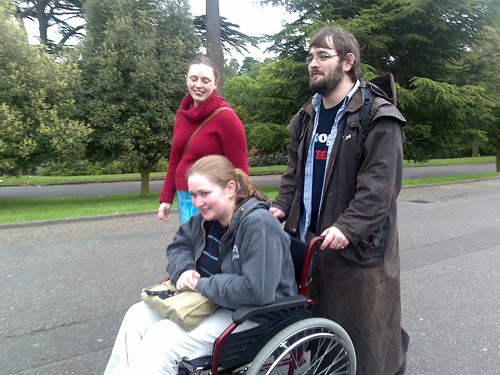A quick summary of a holiday (and a series of associated trips on the side) that Ruth and I took a
fortnight ago (yeah; I’ve been busy). Ruth has already written a little about the trip.
I’d hoped to blog “on the move”, but a combination of low signal and low energy after a day of paddling made this pretty much impossible, so here’s the “grand catch-up”:
Wednesday 27th May
Ruth and I travelled to Shropshire to visit Ruth’s grandma in hospital, but it turned out that she’d been discharged about an hour before we arrived, so we briefly visited her at home.
Then we drove on, up to Preston.
In the evening, we played Chocolate Teapot with my family. I haven’t written about Chocolate Teapot on here yet, but the short summary is that it’s a “light” board
game I’ve put together in the style of Apples to Apples meets Chrononauts… meets Dragons’ Den. So far, folks seem to like it, although I’m still ironing out a few kinks in the rules.
Thursday 28th May
This morning, we were supposed to do something special I’d had planned to commemorate the occasion of Ruth finishing her final exam, but we weren’t able to on account of the weather. I’d kept secret from Ruth what it is we were
eventually to do, and the tension of not knowing (she’s not good at surprises) was very obviously boggling her poor little mind by now.
Instead, we went to Blackpool, rode a few rides (and felt ill thanks to eating a huge chocolate éclair each and then riding on the waltzer on the Central Pier), and played adventure
golf, which Ruth won by a significant margin. And then ate fish & chips, because that’s what one does in Blackpool.
Got tied up with some stuff in East Lancashire early in the evening and missed our chance to get to see Pagan Wanderer Lu on his
weekend mini-tour. Damn.
Ate far too much Chinese food at an all-you-can-eat buffet and gave myself nasty indigestion.
Friday 29th May
Did things in Preston, like buying lots of really really cheap clothes to wear for the remainder of the trip while paddling around in Scotland.
Saturday 30th May
Travelled up to Gretna Green with my dad and Ruth. Left the car at the services there and transferred to a coach full of Go North East employees. Travelled up to Fort William, in the centre of the Nevis mountain range and close to the Great Glen Way and the
Caledonian Canal.
Despite it by now being late in the afternoon, my dad suggested we walk up Ben Nevis, so Ruth and I – joined by two others: John (fellow canoeist) and Dave (the bus driver, although –
that said – about half of the folks on the trip were bus drivers) – followed my dad up the mountain. Dave, who’d apparently never climbed a mountain before, made it about 200 feet up
before he had to give up. Ruth and I got to about 3200ft before we realised that we hadn’t actually eaten since breakfast and had to turn around and get some food, and only my dad and
John made it the extra thousand feet or so to the summit, keeping a spectacular pace going as they did.
There’s photos from Ben Nevis here.
Sunday 31st May
This was our first day in canoes. Ruth and I took one, John and my dad took a second, and the third was taken by a pair of the bus drivers, Yvonne and Claire. We were to paddle our way
up to Inverness, towards the North Sea, over four days. The remainder of the group were to walk the Great Glen Way – about 13 miles longer, and – of course – hillier, but at least
they’d be powered by their legs and not their arms!
The first day was the hardest. It was the longest, which made an impact, but it was also the hottest. I’d not planned for this kind of heat (I’d thought – hey, Scotland, that’ll be a
few degrees colder than Aberystwyth, but it turned out that Northern Scotland was in the middle of some kind of unseasonal heatwave): my case held lots of long sleeves and not enough
pairs of shorts! Out on the lochs and canals, there’s no shade, and on our first day’s paddling, there wasn’t any breeze either. Combine that with 17 miles of rowing, and you’ve got a
recipe for exhaustion.
Ruth overdid it somewhat, and triggered a relapse of her RSI, and she wasn’t able to carry on rowing for the rest of the trip: instead, she joined the walkers group, and a walker
called Martin took her place in my canoe.
Among the many canoeing photos I took, there’s a very cute one of Ruth with one of the
walkers helping her to drink a glass of lemonade because her arms were too broken to lift the glass for herself.
Monday 1st June
The second day’s canoeing was a lot shorter, and a lot easier. Martin and I – after a little bit of weaving around the canal and failing to paddle in a straight line – found a great
synchronisation and made a great rowing team. We easily led the other two canoes for most of the remainder of the journey.
On this, the second day, we even beat the walkers along the first half of the route, meeting them part way for lunch on a pebble beach alongside Loch Oich.
One of the hardest bits of canoeing the Caledonian Canal is that British Waterways no longer allow canoes to use the lock gates (there’s a concern that if your boat tipped over you
could be sucked into a sluice gate and held underwater for quite a lot longer than most people can hold their breath for). So we had to pull ashore, lift the boat out, and carry it up
or down each hill. Walking rather than rowing gave our arms a rest, at least, but it’s not easy to lift your boat, your day bag, and your oars and then carry them up a hill.
Tuesday 2nd June
On Tuesday, we were supposed to cover the first half of Loch Ness. At Fort Augustus, we got into the River Ness (it was easier to get the boats than the canal
would have been, from the back garden of the building we’d kept them at), and appreciated for awhile the current helping us along a little. We passed the smallest lighthouse in the
world and headed out onto the Loch.
The wind had picked up, and it was choppy on the Loch. Paddling over waves and against the wind was more challenging than what we were used to, and the six of us adopted a tight
formation in order to keep an eye on one another in case we got into any trouble. We hugged the shore to avoid the worst of the wind, and took an early break at the bottom of the garden
of a waterfront house, where we ate our morning energy snacks.
The wind felt okay in the bay we’d sat in, but as soon as we got back out onto the Loch, we could feel the wind: it was getting stronger. Paddling was very hard, and Martin and I
redoubled our pace several times. It felt like we were making great time – a hard wind in your face and an ache in your arms will give you the illusion of speed – but when we
pulled over and took a break, we looked at the map and realised that we had travelled about half a mile in the last hour. At this rate, we’d barely reach the next Youth Hostel in time
for breakfast… the following day.
We pressed on, and stopped again and I looked up the shipping forecast on my phone. The wind was due to get worse still, with gusts of up to 25 miles per hour. We were already at a
point at which we spent almost as much time going backwards that forwards, and turning sideways to the current resulted in the boats rocking alarmingly and very quickly filling with
water, so we ran them aground, dragged them ashore into a building site, and called for backup to come and pick them up.
The building site turned out to belong to a chap who I’ll hereafter refer to as The Friendliest Man In Scotland, who was quite unsympathetic to the idea of us sitting around and waiting
for rescue from the backup vehicle, and shouted and swore and threatened legal action quite a lot. While we waited for the rescue vehicle, I used my phone to find XSS vulnerabilities in
his website. You know, like this one.
After we’d got rid of the canoes, we raced to try to catch up with the walkers, who were a couple of hours ahead, finally reaching them a little while after they’d reached the cabins in
which we’d be spending our next night. It was disappointing to not be able to canoe the rest of the distance, but it really wouldn’t have been possible to go any further this day, and
the weather forecase didn’t look any better for the day after (it turned out to be wrong, but we didn’t know that when we had the canoes returned to their owner).
Wednesday 3rd June
And so we canoeists joined the walkers for the very last day of the Scottish trip. The walk was long and arduous, and Ruth and I probably ought to have set off earlier, because we were
right at the back of the group when we entered Inverness, and we actually had to cheat and catch a bus for the final mile in order to not keep them waiting at Inverness Castle for any
longer than we already had.
In summary, canoeing across Scotland was… exhausting. Even (and perhaps especially) for the bits that we weren’t actually in canoes. But it was also a great opportunity to see that
beautiful country from a new angle – from water level, looking up at the Munroes and along at the Lochs. It could be beautifully still and calm out in the middle of the bigger lochs,
and it was great to just stop and sip some water and take in quite how magestic the mountains of Scotland actually are.
At Inverness, we took victory photos (here they are), had a quick McDonalds meal,
and got back on the coach to Gretna, then drove back down to Preston.
Thursday 4th June
On Thursday morning, we finally managed to do the thing we’d tried to do the previous week… weather conditions were at last favourable for: a trip in a hot air balloon (thanks,
Pendle Balloon Company)!
Ruth was suitably surprised.
The whole experience was a lot of fun, and everybody present got roped in to helping lay out the balloon, inflate it with cold air, check and disentangle the control lines (and all the
same stuff again but in reverse at the opposite end).
It’s amazing quite how gentle a balloon take-off is. While the pilot fired the (hot!) burners in a full burn ready for takeoff, I glanced out of the side of the basket and down at the
ground… and realised it was slowly moving along underneath us – we were airborne, and I hadn’t even noticed!
We sailed around at 3,500-5,500 feet for awhile, looking down over mid-Lancashire. We got a great view of Houghton Tower, where I’ve been to their annual open air classical concert a
number of
times (including some I didn’t manage to blog about). Ruth geeked out about different kinds of road
junctions and their comparative space/throughput efficiency trade-offs. We came in low over fields of cows and horses and confused the livestock as they trotted towards the barns for
their morning feed.
And after an hour of sailing around, we bumped down into a field (which happened to double as a microlite runway, which was convenient) and all helped to pack the balloon away. And it
was awesome.
There’s photos from this, too: here they are.
Afterwards
Finally (after a celebratory friend breakfast at a restaurant near where the balloon launched from), we hit the road and got ourselves back to Aberystwyth. It’d been a busy, exhausting,
but fun week.













